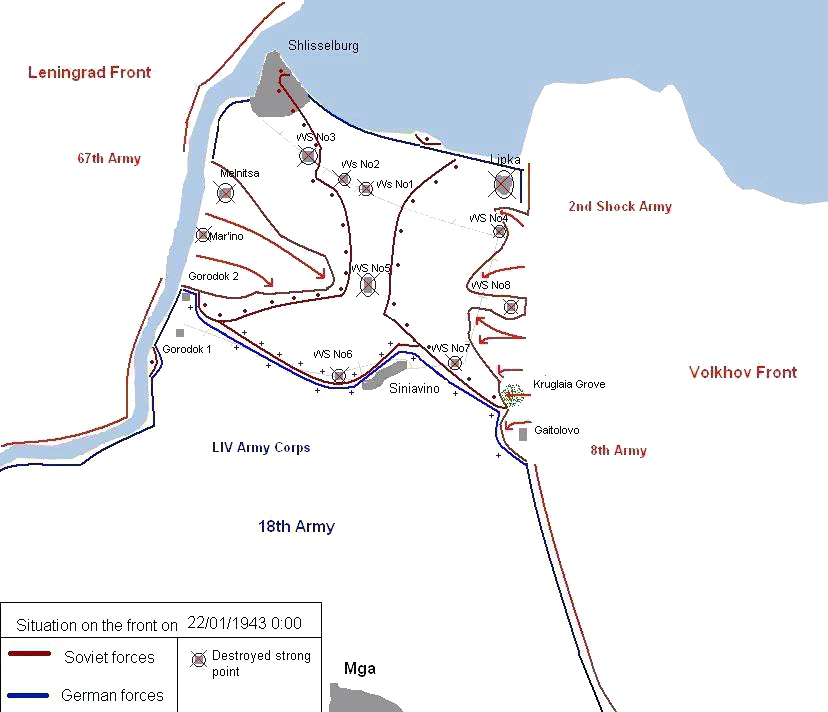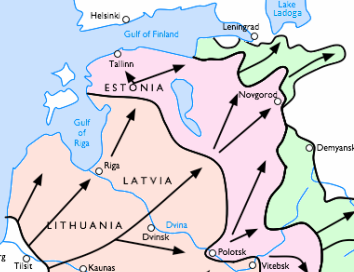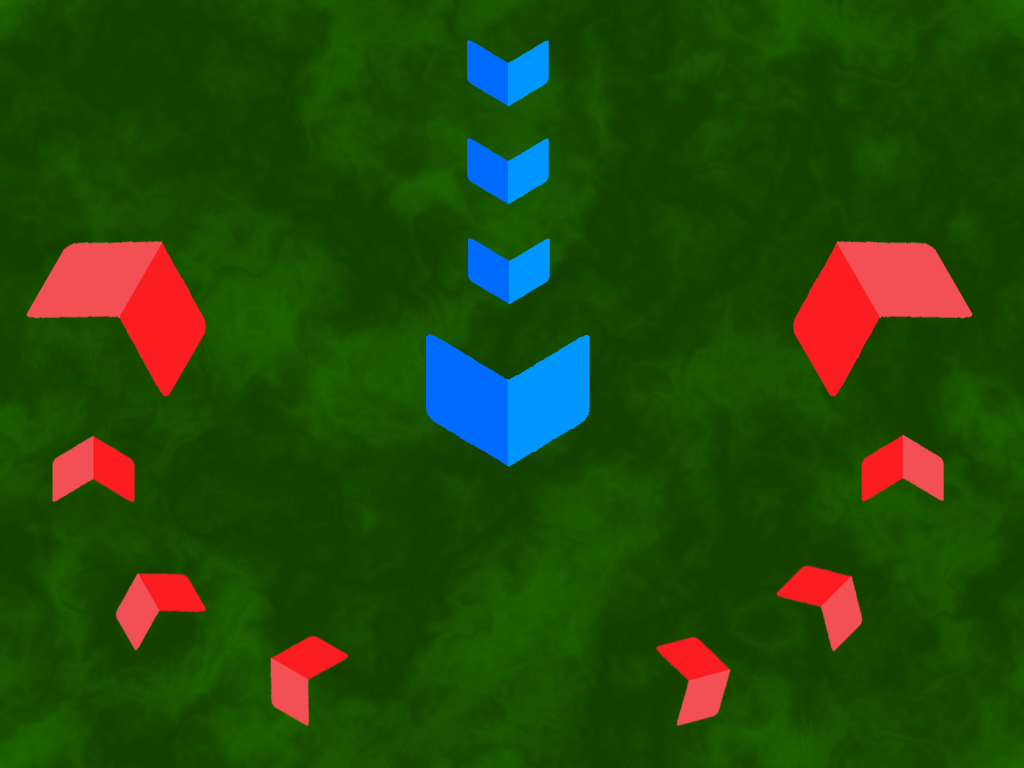|
Battle Of Krasny Bor
The Battle of Krasny Bor was part of the Soviet Union, Soviet offensive Operation Polyarnaya Zvezda in the Eastern Front (World War II), Eastern Front of World War II. It called for a pincer attack near Saint Petersburg, Leningrad to build on the success of Operation Iskra and completely lift the siege of Leningrad, in the process encircling a substantial part of the German 18th Army (Wehrmacht), 18th Army. The offensive near the town of Krasny Bor, Tosnensky District, Leningrad Oblast, Krasny Bor formed the western arm of the pincer. The Soviet offensive began on Wednesday, 10 February 1943, and produced noticeable gains on the first day but rapidly became a stalemate. The strong defense by the Spanish Blue Division and the German SS Polizei Division gave the German forces time to reinforce their positions. By February 13, the Soviet forces had ceased their offensive in this sector. Background The siege of Leningrad The siege of Leningrad began in early autumn 1941. By Se ... [...More Info...] [...Related Items...] OR: [Wikipedia] [Google] [Baidu] |
Eastern Front (World War II)
The Eastern Front, also known as the Great Patriotic War (term), Great Patriotic War in the Soviet Union and its successor states, and the German–Soviet War in modern Germany and Ukraine, was a Theater (warfare), theatre of World War II fought between the European Axis powers and Allies of World War II, Allies, including the Soviet Union (USSR) and Polish Armed Forces in the East, Poland. It encompassed Central Europe, Eastern Europe, Northern Europe, Northeast Europe (Baltic states, Baltics), and Southeast Europe (Balkans), and lasted from 22 June 1941 to 9 May 1945. Of the estimated World War II casualties, 70–85 million deaths attributed to World War II, around 30 million occurred on the Eastern Front, including 9 million children. The Eastern Front was decisive in determining the outcome in the European theatre of World War II, European theatre of operations in World War II, eventually serving as the main reason for the defeat of Nazi Germany and the Axis ... [...More Info...] [...Related Items...] OR: [Wikipedia] [Google] [Baidu] |
63rd Guards Rifle Division
63rd may refer to: ;Metro stations *Ashland/63rd (CTA station), on the Green Line *East 63rd-Cottage Grove (CTA), on the Green Line *63rd (CTA Red Line), on the Red Line *63rd Street station (SEPTA Market–Frankford Line) on the Market-Frankford Line in West Philadelphia ;Railroad stations *63rd Street (Metra station) an electric commuter railroad shared by the Metra Electric service and South Shore Line (NICTD) in Chicago ;Trolley stops *63rd and Malvern Loop (SEPTA station) a terminus of one of the SEPTA Subway–Surface Trolley Lines in Northwest Philadelphia *63rd Street station (SEPTA Route 15) The G, formerly known as the Route 15 Trolley, is a streetcar line in the SEPTA Metro network that runs along Girard Avenue through North Philadelphia, North and West Philadelphia, Pennsylvania. Service is operated by the SEPTA#City Transit Divi ..., a SEPTA Route 15 trolley stop in Carrol Park, Philadelphia ;Metro lines * 63rd Street Line of the New York City Subway, two li ... [...More Info...] [...Related Items...] OR: [Wikipedia] [Google] [Baidu] |
STAVKA
The ''Stavka'' ( Russian and Ukrainian: Ставка, ) is a name of the high command of the armed forces used formerly in the Russian Empire and Soviet Union and currently in Ukraine. In Imperial Russia ''Stavka'' referred to the administrative staff, and to the General Headquarters in the late 19th-century Imperial Russian armed forces and subsequently in the Soviet Union. In Western literature it is sometimes written in uppercase (''STAVKA''), although it is not an acronym. ''Stavka'' may refer to its members, as well as to the headquarters location (its original meaning from the old Russian word '' ставка'', 'tent'). Stavka of the Supreme Commander during World War I The commander-in-chief of the Russian army at the beginning of World War I was Grand Duke Nicholas Nicholaievitch, a grandson of Tsar Nicholas I. Appointed at the last minute in August 1914, he played no part in formulating the military plans in use at the beginning of the war. Nikolai Yanushke ... [...More Info...] [...Related Items...] OR: [Wikipedia] [Google] [Baidu] |
Volkhov Front
The Volkhov Front () was a major formation of the Red Army during the first period of the Second World War. It was formed as an expediency of an early attempt to halt the advance of the Wehrmacht Army Group North in its offensive thrust towards Leningrad. Initially the front operated to the south of Leningrad, with its flank on Lake Ladoga. First formation The Volkhov Front was formed on 17 December 1941 from the left wing of the Leningrad Front and elements of the Reserve of the Supreme High Command ('' Stavka'' Reserve) during the conduct of the Tikhvin Offensive operation under the command of the Army General Kirill Meretskov, with General Grigory Stelmakh (former commander of the 4th Army) as Chief of Staff and Army Commissar of 1st rank A.I.Zaporozhets.Meretskov, On the service of the nation, Ch.6 Initially Sokolov's 26th Army (later 2nd Shock Army) and Galanin's 59th Armies were allocated to the Front's formation. The Front also included Meretskov's 4th Army and ... [...More Info...] [...Related Items...] OR: [Wikipedia] [Google] [Baidu] |
Kirill Meretskov
Kirill Afanasievich Meretskov (; – 30 December 1968) was a Soviet Union, Soviet military commander. Having joined the Communist Party in 1917, he served in the Red Army from 1920. During the Winter War of 1939–1940 against Finland, he had the task of penetrating the Mannerheim Line as commander of the 7th Army (Soviet Union), 7th Army. He was awarded the title of Hero of the Soviet Union shortly afterwards. The NKVD arrested Meretskov at the start of Eastern Front (World War II), invasion of the Soviet Union. Released two months later, he returned to command the 7th Army and later the Volkhov Front during the 1941–1944 siege of Leningrad. He commanded the Karelian Front from February 1944, notably the Petsamo–Kirkenes Offensive of October 1944. From April 1945 he was assigned to the Soviet Far East, Far East, where he commanded a Front (military formation), front during the Soviet invasion of Manchuria, Soviet invasion of Japanese Manchuria. During the war he reached the ... [...More Info...] [...Related Items...] OR: [Wikipedia] [Google] [Baidu] |
Leningrad Front
The Leningrad Front () was formed during the 1941 German approach on Leningrad (now Saint Petersburg) by dividing the Northern Front into the Leningrad Front and Karelian Front on August 27, 1941. History The Leningrad Front was immediately given the task of containing the German drive towards Leningrad and defending the city from the approaching Army Group North. By September 1941, German forces to the south were effectively stopped on the outskirts of Leningrad, initiating the two-and-a-half-year-long siege of Leningrad. Although Finnish forces to the north stopped at the old Finnish–Soviet border, the Leningrad front suffered severe losses on the Finnish Front. From September 8, soldiers of the front were forced to conduct operations under the conditions of a blockade, with very little supply. Some supplies did reach the city however via the lake Road of Life. During the blockade, the front executed various offensive and defensive operations, until finally with the h ... [...More Info...] [...Related Items...] OR: [Wikipedia] [Google] [Baidu] |
Siege Of Leningrad
The siege of Leningrad was a Siege, military blockade undertaken by the Axis powers against the city of Leningrad (present-day Saint Petersburg) in the Soviet Union on the Eastern Front (World War II), Eastern Front of World War II from 1941 to 1944. Leningrad, the country's second largest city, was besieged by Nazi Germany, Germany and Finland for 872 days, but never captured. The siege was the List of sieges, most destructive in history and possibly the List of battles by casualties#Sieges and urban combat, most deadly, causing an estimated 1.5 million deaths, from a prewar population of 3.2 million. It was not classified as a war crime at the time, but some historians have since classified it as a genocide due to the intentional destruction of the city and the systematic starvation of its civilian population. p. 334 In August 1941, Nazi Germany, Germany's Army Group North reached the suburbs of Leningrad as Finnish forces moved to encircle the city from the north. Land ... [...More Info...] [...Related Items...] OR: [Wikipedia] [Google] [Baidu] |
Operation Iskra
Operation Iskra (), a Soviet military operation in January 1943 during World War II, aimed to break the Wehrmacht's siege of Leningrad. Planning for the operation began shortly after the failure of the Sinyavino Offensive (1942), Sinyavino Offensive. The German defeat in the Battle of Stalingrad in late 1942 had weakened the German front. By January 1943, Soviet forces were planning or conducting offensive operations across the entire German-Soviet Front, especially in southern Russia; Iskra formed the northern part of the wider Soviet 1942–1943 winter counteroffensive.Glantz p. 259 The operation was conducted by the Red Army's Leningrad Front, Volkhov Front, and the Baltic Fleet#Soviet era, Baltic Fleet from 12 to 30 January 1943 with the aim of creating a land connection to Leningrad. Soviet forces linked up on 18 January, and by 22 January, the front line had stabilised. The operation successfully opened a land corridor wide to the city. A railroad was swiftly built throug ... [...More Info...] [...Related Items...] OR: [Wikipedia] [Google] [Baidu] |
Pincer Attack
The pincer movement, or double envelopment, is a military maneuver in which forces simultaneously attack both flanks (sides) of an enemy formation. This classic maneuver has been important throughout the history of warfare. The pincer movement typically occurs when opposing forces advance towards the center of an army that responds by moving its outside forces to the enemy's flanks to surround it. At the same time, a second layer of pincers may attack the more distant flanks to keep reinforcements from the target units. Description A full pincer movement leads to the attacking army facing the enemy in front, on both flanks, and in the rear. If attacking pincers link up in the enemy's rear, the enemy is encircled. Such battles often end in surrender or destruction of the enemy force, but the encircled force can try to break out. They can attack the encirclement from the inside to escape, or a friendly external force can attack from the outside to open an escape route. ... [...More Info...] [...Related Items...] OR: [Wikipedia] [Google] [Baidu] |
Operation Polyarnaya Zvezda
Operation Polar Star (Russian: Операция Полярная звезда, ''Operatsia Polyarnaya Zvezda'') was an operation conducted by the Soviet Leningrad, Volkhov and Northwestern Fronts in February and March 1943. The operation was planned by Georgy Zhukov in the wake of the successful Operation Iskra and envisaged two separate encirclements. One was to be carried out in the north by the Leningrad and Volkhov Fronts near Mga and one was planned to be carried out further to the south, by the Northwestern Front, near Demyansk. The operation succeeded in recapturing the Demyansk salient but failed to encircle the German forces. The northern part of the operation failed, without gaining much ground. With the battles in the south near Kharkov and, later, Kursk using reinforcements for both sides, the frontline near Leningrad stabilised until July 1943. Battle The German's successful evacuation of the Demyansk salient before the battle shortened the frontline enough to b ... [...More Info...] [...Related Items...] OR: [Wikipedia] [Google] [Baidu] |
Soviet Union
The Union of Soviet Socialist Republics. (USSR), commonly known as the Soviet Union, was a List of former transcontinental countries#Since 1700, transcontinental country that spanned much of Eurasia from 1922 until Dissolution of the Soviet Union, it dissolved in 1991. During its existence, it was the list of countries and dependencies by area, largest country by area, extending across Time in Russia, eleven time zones and sharing Geography of the Soviet Union#Borders and neighbors, borders with twelve countries, and the List of countries and dependencies by population, third-most populous country. An overall successor to the Russian Empire, it was nominally organized as a federal union of Republics of the Soviet Union, national republics, the largest and most populous of which was the Russian SFSR. In practice, Government of the Soviet Union, its government and Economy of the Soviet Union, economy were Soviet-type economic planning, highly centralized. As a one-party state go ... [...More Info...] [...Related Items...] OR: [Wikipedia] [Google] [Baidu] |






